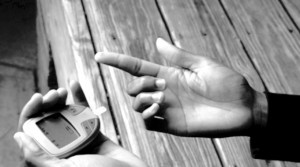Slowing down your diabetes
7th December 2015 · 0 Comments
By Dr. Todd G. Prewitt
Contributing Writer
(Special from New America Media) – After a diagnosis of diabetes, people have a variety of reactions. Some want to give up, some get very active in their health and others just go along for the ride.
Regardless of which reaction you have had, one thing is certain, diabetes doesn’t get better without you! While there is no known cure for diabetes, by taking an active role in controlling your blood sugar level, you may be able to slow down your diabetes. You may even improve your overall health along the way.
Diabetes is a group of diseases marked by high levels of blood glucose resulting from problems in how insulin is produced, how insulin works, or both. People with diabetes may develop serious complications such as heart disease, stroke, kidney failure, blindness, and premature death. 
More than nine million adults over the age of 65 have been diagnosed with diabetes in the United States. The Centers for Disease Control and Prevention estimates 29.1 million people or 9.3 percent of the U.S. population have diabetes. Yet 27.8 percent of people with diabetes are undiagnosed.
Health disparities are even greater for people of color. According to the U.S. Department of Health and Human Services Office of Minority Health, African-American adults are 80 percent more likely to be diagnosed with diabetes than non-Hispanic white adults and two times as likely as them to die from diabetes. Hispanic adults are almost twice as likely as non-Hispanic whites to be diagnosed with diabetes by a physician and are 1.5 times more likely to die from the disease than their white counterparts.
Basic treatment steps to help manage and live with their diabetes include:
Reframe how you think about your self-care. There’s no doubt that dealing with diabetes can be a lot of work. It can be depressing and you can feel deprived. However, you may find the whole situation easier if you change the way you look at caring for yourself. Diabetes isn’t a punishment for unhealthy past behavior. It’s a motivator for healthy future behavior.
Your Treatment Goal – Your doctor likely has told you about monitoring your sugar levels with a blood test called a hemoglobin A1c every three to six months. This test establishes your average blood sugar level for the past several months and provides you and your physician a measure of how your diabetes treatment plan is working. A measure of less than 7 percent is ideal but you and your doctor will establish the right level for you. Know that number and work with your doctor to adjust your treatment to achieve it!
Work closely with your doctor. It is very important to take all of your medications as directed by your doctor. Diabetes affects many other systems in the body so keep your routine doctor appointments. Get regular blood pressure tests, cholesterol screenings, eye exams, and an annual kidney-function test. Be sure to practice healthy foot care habits and address any foot problems or changes immediately. Sores can quickly lead to big problems for the feet of people with diabetes. Don’t let that happen to you!
Escalating Medication Therapy. Sometimes diabetes can be controlled through lifestyle choices such as diet and exercise, however, most everyone will need to take medication. Remember how important your Goal A1c number is? If you are not achieving it with one medication it may be important to add another drug and sometimes insulin is really the best next step, even early in treatment. Insulin therapy can be demanding, but it is a key component to maintain your health. Newer versions may allow you to only require one shot a day.
Lose weight. You hear this over and over again, but losing weight – if you can – really is incredibly helpful. Losing as little as 5 percent of your weight can improve your health. Think of it as another treatment for your diabetes.
Stick to your healthy eating plan as much as you possibly can. The good news here is that the more you stick to it, the more your body and taste buds will adjust.
Be physically active. A common goal for physical activity is 30 to 60 minutes five or six days a week. Try to hit the 60-minutes workout as many days as possible. (Of course, check with your doctor to make sure that physical activity is right for you.)
Reaching your goals with diabetes may seem like a lot of work, but finding ways to incorporate these healthy tips into your everyday routine will quickly make it feel normal for you. Stay healthy, you’re worth the effort!
This article originally published in the December 7, 2015 print edition of The Louisiana Weekly newspaper.



